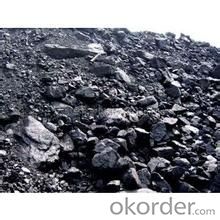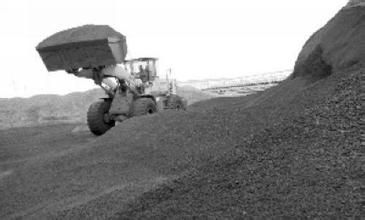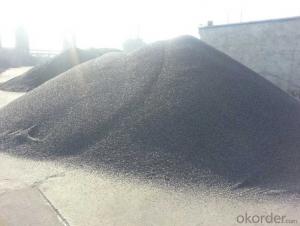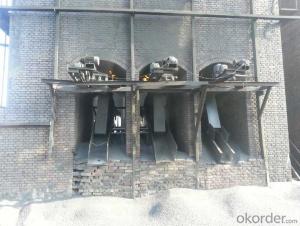Injection Carbon FC90-95 with High Quality
- Loading Port:
- Lianyungang
- Payment Terms:
- TT OR LC
- Min Order Qty:
- 20 m.t.
- Supply Capability:
- 3500 m.t./month
OKorder Service Pledge
OKorder Financial Service
You Might Also Like
Packaging & Delivery
25kgs/50kgs/1ton per bag or as buyer's request
Specifications
Calcined Anthracite
Fixed carbon: 90%-95%
S: 0.5% max
Size: 0-3. 3-5.3-15 or as request
It used the high quality anthracite as raw materials through high temperature calcined at over 2000 by the DC electric calciner with results in eliminating the moisture and volatile matter from anthracite efficiently, improving the density and the electric conductivity and strengthening the mechanical strength and anti-oxidation. It has good characteristics with low ash, low resistvity, low sulphur, high carbon and high density. It is the best material for high quality carbon products.
Advantage and competitive of caclined anthracite:
1. strong supply capability
2. fast transportation
3. lower and reasonable price for your reference
4.low sulphur, low ash
5.fixed carbon:95% -90%
6..sulphur:lower than 0.3%
General Specification of Calcined Anthracite:
| FC | 95 | 94 | 93 | 92 | 90 |
| ASH | 4 | 5 | 6 | 6.5 | 8.5 |
| V.M. | 1 | 1 | 1 | 1.5 | 1.5 |
| S | 0.3 | 0.3 | 0.3 | 0.35 | 0.35 |
| MOISTURE | 0.5 | 0.5 | 0.5 | 0.5 | 0.5 |
Pictures



Company information:
China National Building Materials Group is a stated -owned enterprise in charge of administrative affairs in China buiding materials industry.Established in 1984 CNBM is a large group corporation of building materials with total assets of 25 billion and a total stuff of 30000 CNBM now owns 200 subordinating firms of solely owned and joint-venture companies.
- Q:How do you remove car carbon?
- 3, running high speed can flush carbon deposition? Running high speed, you can really use the airflow on the airway erosion, wash away part of the carbon deposition. So, if you happen to go out, there are high-speed, national road two choices, you may choose to pull back to speed. But, Ma director thinks, if be in order to "flush carbon deposit" specially, want to run high speed, do not have this necessity. "It is a waste of time, and the cost of oil, extra high speed tolls, the effect is better to do a maintenance 4S shop!" 4, improve the shift speed, such as the original speed 2000rpm shift, modified 2500rpm conversion, generated can prevent carbon deposition, but also to protect the engine? Ma director said, low speed the shift, is often said that the "drag block", the car is easy to knock, the combustion of gasoline is not sufficient to carbon deposition. But it's not necessary for people to increase gear speed - that will increase fuel consumption and cause premature wear of clutch friction plates. So, manual transmission of the car, 1.6 ~ 2.0L displacement, about 2000 rpm shift is more economical, and no need to improve; and automatic car, pay attention not to slam the gas.
- Q:What are the effects of carbon emissions on the stability of grasslands?
- Carbon emissions can have various negative effects on the stability of grasslands. Increased levels of carbon dioxide in the atmosphere can contribute to climate change, resulting in altered precipitation patterns and increased temperatures. These changes can cause shifts in grassland ecosystems, leading to reduced plant productivity, changes in species composition, and even the loss of grassland habitats. Additionally, carbon emissions can indirectly impact grasslands by contributing to the acidification of rain, which can harm soil health and hinder the growth of grasses. Overall, carbon emissions pose a significant threat to the stability and resilience of grassland ecosystems.
- Q:What is carbon fixation?
- Carbon fixation is the process by which carbon dioxide from the atmosphere is converted into organic compounds, primarily through photosynthesis in plants.
- Q:What is the density of carbon steel and alloy steel?
- Material name density g/cm3Grey cast iron 7.7.7Malleable iron 7.7.4Cast steel 7.8Industrial pure iron 7.87Plain carbon steel 7.85Quality carbon steel 7.85Carbon tool steel 7.85Free cutting steel 7.85
- Q:How can we reduce carbon emissions from transportation?
- Reducing carbon emissions from transportation is crucial to mitigate climate change and improve air quality. There are several strategies that can be implemented to achieve this goal: 1. Promote the use of electric vehicles (EVs): Encouraging the adoption of electric cars, buses, and bikes can significantly reduce carbon emissions. Governments can provide incentives such as tax credits, rebates, and subsidies to make EVs more affordable. Expanding the charging infrastructure network is also essential to alleviate range anxiety and increase EV adoption. 2. Invest in public transportation: Enhancing and expanding public transportation systems can reduce the number of individual vehicles on the road, leading to fewer emissions. Governments should prioritize the development of efficient and accessible public transport networks, including buses, trains, and trams. 3. Encourage active transportation: Encouraging walking, cycling, and other forms of active transportation can significantly reduce carbon emissions from short-distance trips. Building safe and convenient infrastructure, such as bike lanes and pedestrian-friendly streets, can promote these modes of transport. 4. Improve fuel efficiency: Encouraging the production and purchase of vehicles with higher fuel efficiency standards can greatly reduce carbon emissions. Governments should implement strict regulations and offer incentives to manufacturers that produce fuel-efficient vehicles. 5. Develop and promote alternative fuels: Investing in the development and use of alternative fuels, such as biofuels, hydrogen, and renewable natural gas, can help reduce carbon emissions from transportation. Governments should provide incentives and support research and development efforts to accelerate the adoption of these cleaner fuels. 6. Implement congestion pricing and road tolls: Charging drivers for using congested roads or entering certain areas can reduce traffic congestion and encourage the use of public transportation or carpooling. By discouraging unnecessary car trips, carbon emissions can be significantly reduced. 7. Encourage telecommuting and flexible work arrangements: Promoting telecommuting and flexible work arrangements can reduce the number of commuting trips and, consequently, carbon emissions. Governments and businesses can provide incentives to encourage companies to adopt these practices. 8. Rethink urban planning: Designing cities and communities with mixed land-use patterns, where residential, commercial, and recreational areas are within close proximity, can reduce the need for long commutes and promote active transportation. 9. Raise awareness and provide education: Educating the public about the environmental impact of transportation choices and the benefits of sustainable modes of transport is crucial. Governments and organizations should launch campaigns to raise awareness and provide information about the carbon footprint of different transportation options. Reducing carbon emissions from transportation requires a multifaceted approach involving government policies, technological advancements, and changes in individual behavior. By implementing these strategies, we can make significant progress in reducing carbon emissions and creating a more sustainable transportation system.
- Q:How to test aldehyde group and carbon carbon double bond in acrolein
- Can be oxidized into carboxyl aldehyde with silver ammonia solution or new copper hydroxide,
- Q:What is the starting temperature and final forging temperature of carbon steel?
- The forging temperature range should be as wide as possible, to reduce forging times, improve productivity.1. initial forging temperatureInitial forging temperature is blank began forging temperature should be understood as the highest heating temperature allows steel or alloy in the heating furnace. The furnace before removing from the blank to the forging equipment to forging blank, blank size according to the delivery method and heating furnace and forging a distance between the equipment, there are a few blank tens of degrees of temperature drop. Therefore, really began forging a low temperature, the initial forging blank before, should try to reduce the temperature drop.
- Q:How do plants and trees absorb carbon dioxide?
- Plants and trees absorb carbon dioxide through a process called photosynthesis. During photosynthesis, they use sunlight, water, and chlorophyll to convert carbon dioxide into glucose and release oxygen as a byproduct. This helps in reducing the amount of carbon dioxide in the atmosphere and contributes to maintaining a balance in the Earth's carbon cycle.
- Q:How does carbon pricing work?
- Carbon pricing is a market-based approach that aims to reduce greenhouse gas emissions by putting a price on carbon emissions. It works by putting a financial cost on the release of carbon dioxide and other greenhouse gases into the atmosphere, which are major contributors to climate change. There are primarily two types of carbon pricing mechanisms: carbon taxes and cap-and-trade systems. Under a carbon tax, a fixed price per ton of carbon emissions is set, and emitters are required to pay this tax based on their emissions. The tax can be levied at various stages of the supply chain, such as at the point of extraction, production, or consumption. The idea behind a carbon tax is to create an economic disincentive for emitting carbon and encourage industries and individuals to reduce their emissions. Cap-and-trade systems, on the other hand, set a limit or cap on the total amount of carbon emissions allowed within a specific jurisdiction. This cap is divided into allowances, which represent the right to emit a certain amount of carbon. These allowances are either allocated or auctioned off to emitters in the form of permits. Emitters can then trade these permits amongst themselves in a market. If an emitter exceeds their allocated allowances, they must purchase additional permits from others who have surplus allowances. This creates a market-based incentive for reducing emissions as those who can reduce their emissions more cost-effectively can sell their extra allowances to those who are unable to. Both carbon taxes and cap-and-trade systems aim to internalize the cost of carbon emissions into the economy, making it more expensive to pollute and incentivizing the adoption of cleaner technologies and practices. By putting a price on carbon, these mechanisms provide economic signals that encourage businesses, industries, and individuals to invest in low-carbon alternatives, energy efficiency, and innovation. They also provide a revenue stream for governments, which can be used to fund climate change mitigation and adaptation efforts, renewable energy projects, or to reduce other taxes. Overall, carbon pricing mechanisms are designed to create economic incentives for reducing greenhouse gas emissions, promoting the transition to a low-carbon economy, and mitigating climate change. While they may not be a silver bullet solution, they are widely recognized as one of the most effective tools to drive emission reductions and combat climate change.
- Q:How do you remove the carbon stains on your clothes?
- 1, first pour alcohol on clothes, fountain pen scratches, every scratch should be evenly covered with alcohol, alcohol should be used at a concentration of not less than 75% of the medical alcohol.2, pour the clothes down, put this side of the alcohol up, try not to touch other surfaces of the clothes, otherwise, the color of the pen or ballpoint pen may be stained with other parts of the clothes.3, with ordinary washbasin, ready most of the basin of water, and then will be full of two bottles of bleach water poured in the water, pay attention to must be full two bottle cap.4, take a stir, and then add a little washing powder, this amount can be mastered.5, after a little mixing, so that washing powder can be fully dissolved in water. Well, now soak your clothes in water for twenty minutes.
1. Manufacturer Overview |
|
|---|---|
| Location | |
| Year Established | |
| Annual Output Value | |
| Main Markets | |
| Company Certifications | |
2. Manufacturer Certificates |
|
|---|---|
| a) Certification Name | |
| Range | |
| Reference | |
| Validity Period | |
3. Manufacturer Capability |
|
|---|---|
| a)Trade Capacity | |
| Nearest Port | |
| Export Percentage | |
| No.of Employees in Trade Department | |
| Language Spoken: | |
| b)Factory Information | |
| Factory Size: | |
| No. of Production Lines | |
| Contract Manufacturing | |
| Product Price Range | |
Send your message to us
Injection Carbon FC90-95 with High Quality
- Loading Port:
- Lianyungang
- Payment Terms:
- TT OR LC
- Min Order Qty:
- 20 m.t.
- Supply Capability:
- 3500 m.t./month
OKorder Service Pledge
OKorder Financial Service
Similar products
New products
Hot products





























